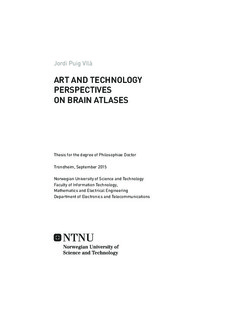| dc.contributor.advisor | Perkis, Andrew | |
| dc.contributor.author | VIlà, Jordi Puig | |
| dc.date.accessioned | 2015-12-23T15:02:29Z | |
| dc.date.available | 2015-12-23T15:02:29Z | |
| dc.date.issued | 2015 | |
| dc.identifier.isbn | 978-82-326-1159-1 | |
| dc.identifier.issn | 1503-8181 | |
| dc.identifier.uri | http://hdl.handle.net/11250/2371332 | |
| dc.description.abstract | The research presented in this thesis explores an approach to neuroimaging which concerns the use of Brain Atlases and Neuronavigation techniques. The main focus has been to performinvestigations regarding themethods, validity and scope of current visualisations of the brain. Although it is presented at the faculty of Information Technology, Mathematics and Electrical Engineering, this thesis does not focus on a technical research. The thesis does not aim at refining, advancing nor improving the state of the art of neuroimaging technologies but, instead, rethink the methods in order to find unexplored points of view which could ultimately impact and question current neuroimaging practices. Therefore, this thesis has both technical and reflective objectives, and it delivers its materials through practice based research. The hypothesis thesis is pursued with the following research questions: RQ1: Can an interactive installation provoke the reflection on the current scope of brain atlases and neuronavigation? RQ2: Can neurosciences benefit from an interactive installation provoking the reflection on the scope of brain atlases? Each of the research questions has been approached with a contribution (C1 and C2) which consequently produced a number of scientific publications, art exhibitions, with their correspondent art catalogues, documentation and press articles, and also software implementations which are open to the public domain. In our research we explore uses of vision technologies to mediate neuronavigation as well as series of prototypes conceiving tools to support neuroscience cooperation. Following are the descriptions of the mentioned contributions: C1: A-me The first contribution of the thesis focuses on how visualisation and navigation technologies used in the surgical environment can have diverging social, cultural, and ethical implications when used in the exhibition space. The aim of this study is to analyse the state of the art of the current visualization and neuronavigation techniques and to develop an alternative device to insert current discussion on Brain Atlases (usually lead by the scientific community) into the creative arena. To do that, an interactive augmented reality installation was developed, which resembles the current instrumentation used in the surgical field. The research has moved towards the assessment of the quality of the system through the evaluation of perceived aesthetics and functionality. The proposed perceptual apparatus results in a design of a novel human-computer interface for neuronavigation. The complete system has been exhibited at several art venues having a great impact on visitor’s perception of the current neurosurgical technologies shredding light into the topics and challenges that concern brain visualization and its limitations. C2: Braincloud The second contribution has been enabled as a consequence to the previous experiences and technologies developed during the first contribution. A-me paved the way for a research on tools to support neuroscience through brain atlases. BrainCloud aims at the definition of a new tool that maps neuroscientists social activities onto a virtual human brain. The application allows to publish, find and collect notes that other researchers have placed on specific areas in the brain. By selecting certain areas of interest the researcher will be updated on a daily basis about the activity of other researchers. BrainCloud is a prototype which has been developed in order to convey a study which gives an overview on the functionalities required as well as general neuroscientists expectations on the tool for the near future. | nb_NO |
| dc.language.iso | eng | nb_NO |
| dc.publisher | NTNU | nb_NO |
| dc.relation.ispartofseries | Doctoral thesis at NTNU;2015:251 | |
| dc.relation.haspart | Paper 1: J. Puig, A. Perkis, F. Lindseth, and T. Ebrahimi, “Towards an Efficient Methodology for Evaluation of Quality of Experience in Augmented Reality” Proceedings of Quality of Multimedia Experience (QoMEX). IEEE,May 2012. <a href="http://dx.doi.org/10.1109/QoMEX.2012.6263864" target="_blank"> http://dx.doi.org/10.1109/QoMEX.2012.6263864</a> (c) 2015 IEEE. Personal use of this material is permitted. Permission from IEEE must be obtained for all other users, including reprinting/ republishing this material for advertising or promotional purposes, creating new collective works for resale or redistribution to servers or lists, or reuse of any copyrighted components of this work in other works. | nb_NO |
| dc.relation.haspart | Paper 2: Puig, A. Perkis, A. S. Hoel, and A. Cassinelli, “A-me: augmented memories” SA ’13: SIGGRAPH Asia 2013 Art Gallery. ACM, Nov. 2013. <a href="http://dx.doi.org/10.1145/2542256.2542264" target="_blank"> http://dx.doi.org/10.1145/2542256.2542264</a> | |
| dc.relation.haspart | Paper 3: J. Puig, A. Perkis, P. Pinel, A. Cassinelli, and M. Ishikawa, “The neuroscience social network project” SIGGRAPH Asia 2013 Posters No. 20. ACM, Nov. 2013 <a href="http://dx.doi.org/10.1145/2542302.2542327 " target="_blank"> http://dx.doi.org/10.1145/2542302.2542327 </a> | |
| dc.relation.haspart | Paper 4: J. Puig, A. Cassinelli, P. Pinel, A. Carusi and A.S. Hoel, “Brain Art-Science: Explorations through A-me and BrainCloud" | |
| dc.title | ART AND TECHNOLOGY PERSPECTIVES ON BRAIN ATLASES | nb_NO |
| dc.type | Doctoral thesis | nb_NO |
| dc.subject.nsi | VDP::Technology: 500::Information and communication technology: 550::Telecommunication: 552 | nb_NO |
